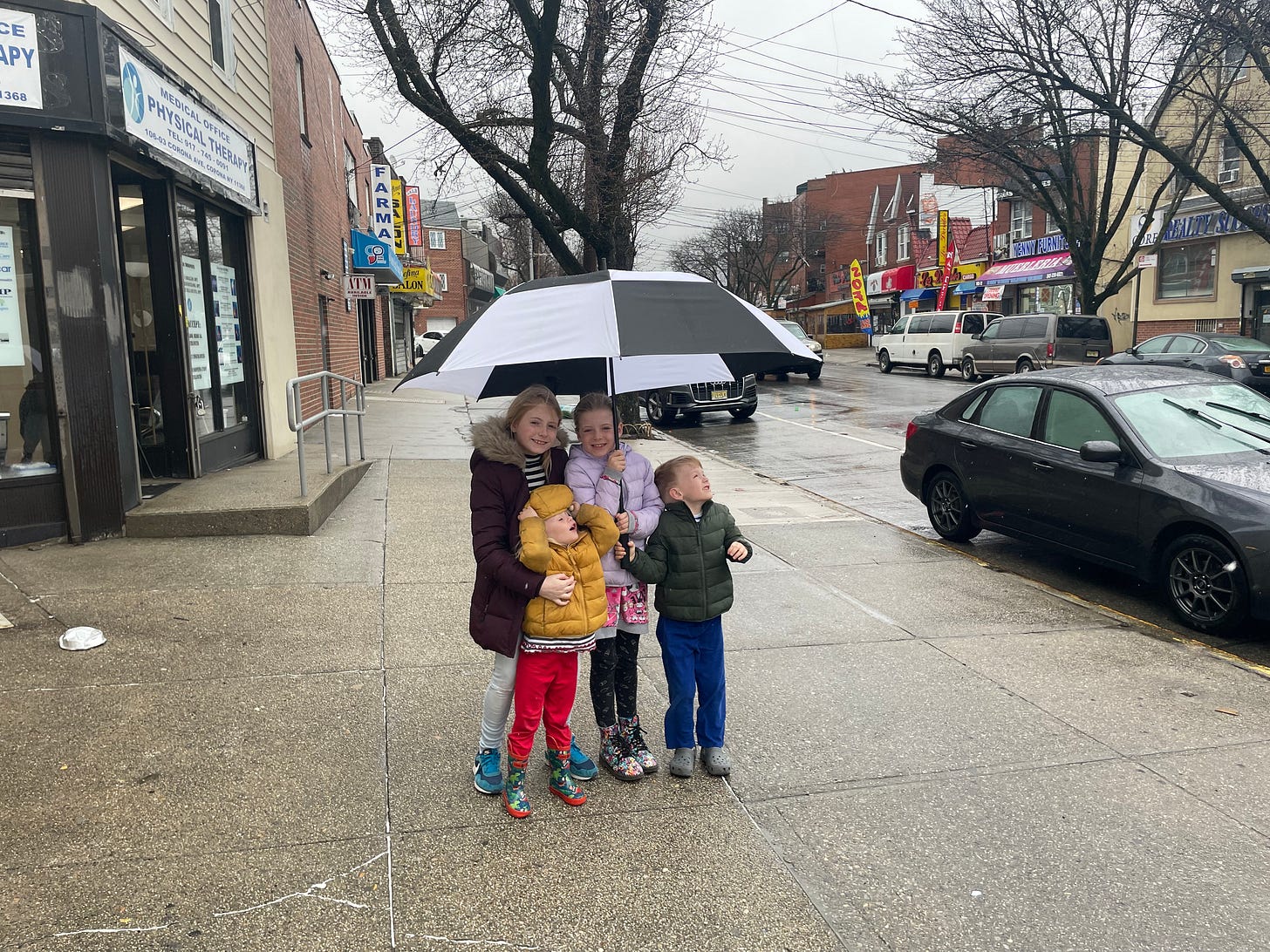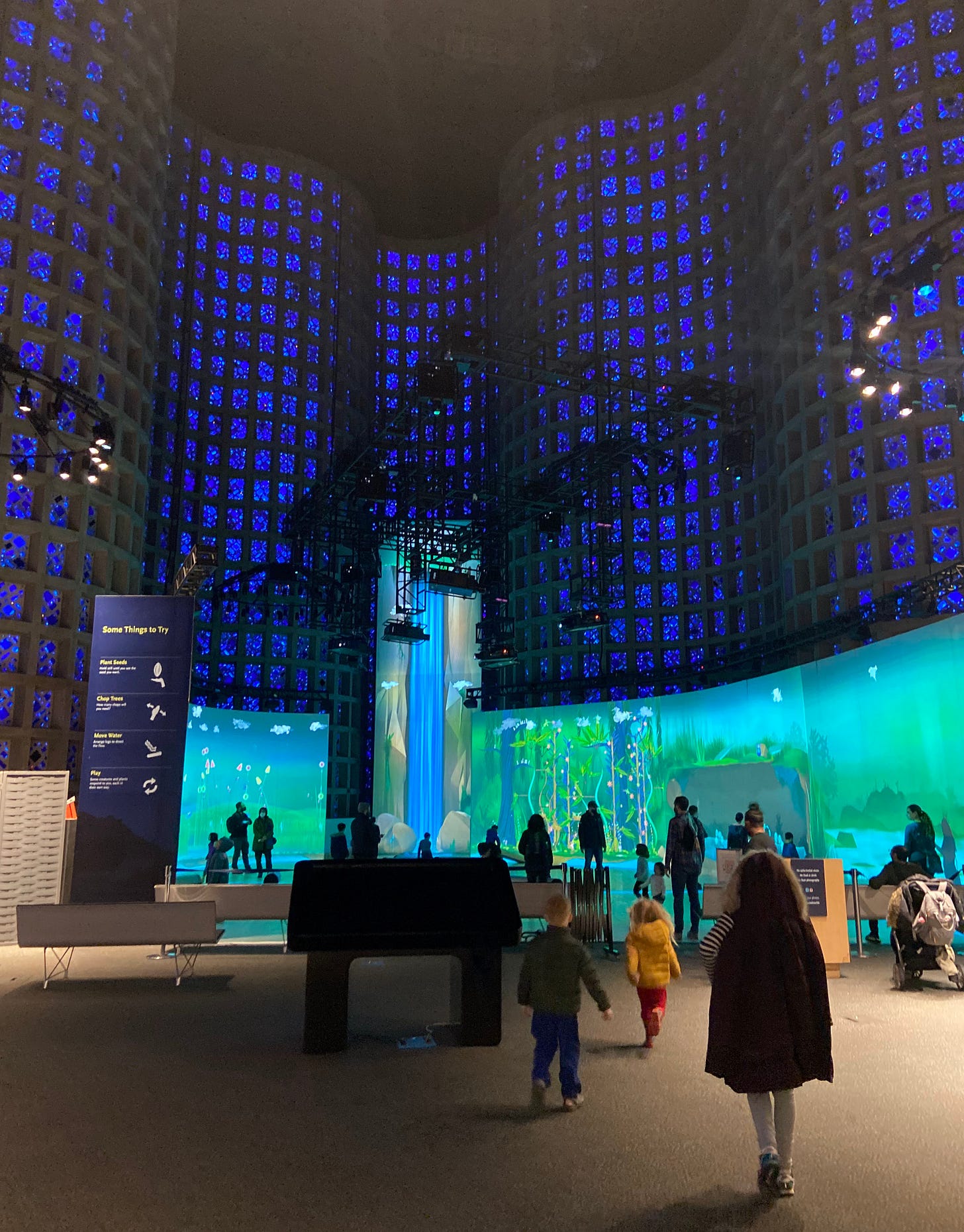We start the day in search of Mexican food, but Corona Avenue feels shuttered–like it’s still emerging from the wreckage of the past two years. Maybe it’s just the gray skies, or maybe it’s that Corona, Queens was one of the neighborhoods hardest hit by covid in 2020, but every restaurant we try seems to be semi-permanently closed, based on our piecemeal translation of the Spanish signs in the windows.
Our desire to escape the cold rain that’s starting to fall outweighs the need for tacos. We find a Peruvian restaurant that’s actually open. We eat under a gilded-framed painting of Jesus on the cross and a big screen television. The kids declare the rotisserie chicken Best Chicken Ever, and dig into the rice and beans, plantains and french fries topped with hotdogs with equal relish. Jim and I convince them that the smoothies they order qualify as dessert.
On exit the rain has turned frozen, so the four of them squeeze under a single umbrella, navigating puddles as an amoebic mass, and we head to the Hall of Science.
We haven’t been to this museum since Eloise was a toddler, and being back reminds me of how much energy we had as first-time parents. Why did we bring her on a forty-five minute subway ride to this museum that she’s only now, at 10-years-old, the right age for? In those early days, still in the city, we were never sure what to do with her. None of our friends had kids yet, so she would get passed around at parties like a pet. “Can I feed her this?” someone would say and show me a tortilla chip or a cherry tomato. No, I knew that at least. And then we’d get up, slightly hungover, and take her somewhere on the subway that we thought she would like.
The building itself is familiar from a past life too: in 2004, the architecture firm I worked for built the addition to the original structure from the 1964 World’s Fair. The sharp angles of that addition still cut a striking contrast to the curvature of Harrison & Abramovitz’s Great Hall. The museum is city-owned, and the boldness of the new space is a relic of Bloomberg-era civic ambition that has worn well over two decades.
10-year-old Eloise’s enthusiasm for science is infectious, her younger siblings falling in line behind her like ants on a log. Heath is ecstatic to learn he can touch everything in sight, unlike at the Natural History Museum. They jockey to control a pint-sized lunar rover. They cue up to retrieve “moon rocks” with a manually operated claw. A 3-D movie that tracks bears through the Alaskan rainforest wins over everyone except Ramona, who can’t keep the glasses on long enough to render the images lifelike.
The Happiness Experiment is my favorite exhibition to walk them through. Perhaps because it dovetails with my personal conviction that as a parent, I am not shaping my children’s personalities so much as teaching them to deal with the people they already are, for better and worse. The main question the Happiness Experiment poses is to what extent we can control our own happiness. There’s a wall where they write post-its about things that have made them happy at different ages. A photobooth where they experiment with facial expressions on cue, then see the portraits added to an onscreen mosaic with other visitors’. I sit on a turf-covered bolder that doesn’t quite feel like the forest it’s intended to imitate, but does remind me that some time in the forest is always a good thing. Happiness, we are told by the didactics, is fleeting. But so is unhappiness.
The highlight for the kids is the interactive Connected Worlds, an interactive video installation in the Great Hall whose purpose I’m not entirely sure of. It’s sort of like a full-body video game. They form digital orbs by raising their hands overhead, drag them across the wall and let them burst. The set up entertains them long enough for Jim and I to sit on a bench and look up at the Great Hall’s hundred-foot, undulating blue walls. It’s all hard surfaces–concrete, resin, and glass–but stare long enough and you feel like you’re underwater or in outer space. Who needs a forest, maybe, when you have architecture.
There is more to see here on another visit: a Science Playground with miniature golf and what looks like water features. We need to come back when the sun is out to explore the rest of Flushing Meadows Corona Park and the World’s Fair structures. And we will return. Hopefully not ten years and three kids later.
GET THERE
7 train to 103rd or 111th Street
EAT
Sabor Peruano (Peruvian. rotisserie chicken, ceviche, salads, plantains, rice and beans)
98-53 Corona Avenue at 99th Street
SEE
47-01 111th Street near 47th Avenue
PLAY






